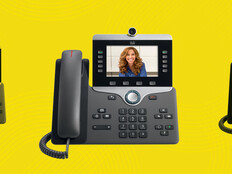Unified Collaboration Strengthens Community Links in Long Island
In the fall of 2018, the Middle Country Public Library (MCPL) badly needed new voice technology, but it also wanted uninterrupted communications for library staff within the institution and with the community.
The installation of Cisco Unified Communications Manager (UCM) 11.5 with Cisco Unity Connection met both requirements, providing enhanced security and functionality without forcing users to climb a steep learning curve, says James Matias, coordinator of computer services and technology at MCPL, which has facilities in the Long Island, N.Y., towns of Centereach and Selden.
“Our previous system was older hybrid digital and analog technology that had reached the end of life — there was no longer any support in the form of security or software updates,” says Matias. “We wanted a new, better phone system, but we didn’t want the implementation to complicate the jobs of the library staff.”
MCPL’s focus on matching technology to user needs is one that Richard Costello, a senior research analyst with IDC's Enterprise Communications Infrastructure service is increasingly seeing in organizations searching for voice and unified collaboration (UC) solutions.
“This used to be a technology buy that was all about cost and features,” Costello says. “UC has become a decision about business value. Organizations are now thinking about the end-user experience, giving the workers the tools they want to do their jobs and the tools they’re comfortable with.”
As they choose UC technology, organizations should be mindful that their needs will change and consider solutions that allow them to add capabilities such as messaging, collaboration and presence, he says. Cloud solutions are gaining traction as they put the burden of upgrades on the service provider, he adds.
VIDEO: Find out how states are working to attract a modern workforce.
Offer More Communication Options with UC Systems
Unlike Cisco UCM, MCPL’s old system’s voicemail didn’t integrate well with its Microsoft Exchange Server and was also hard-wired, so that troubleshooting often required tracing glitches back to the server closet, says Matias.
He and his staff explored cloud solutions but decided on an on-premises implementation of the IP-based Cisco system, which was cost-effective, provided all the functionality the library needed and offered simplified maintenance. UCM integrates fully with Exchange, so full-time library staff are able to access their voicemail through their Exchange email from anywhere.
“The Cisco system also allows us to have options for the future, which is something we were looking for,” Matias says. “We weren’t ready to add conferencing at implementation, but we will want that and perhaps some other features later.”
MCPL used the services of CDW to install the Cisco solution, says Matias. The deployment was performed remotely, after the library gave CDW system access.
“We started with a conference call to figure out what we needed to do, what kind of information we needed and who was going to be taking care of what,” he says. “We also talked about how to make the user experience as similar as possible to that of the old system, which had been around for decades. We were able to work with CDW to do that.”
From the on-premises administrative perspective, Matias and his staff upgraded the library’s HPE Aruba network to handle the increased IP traffic from the new phone system. Integrating the Cisco voice environment into the Aruba network presented a minor hiccup that was quickly overcome, says Matias.
The installation, which was completed in October 2018, included a server in each of the two MCPL buildings, providing failover capability; 116 VoIP phones; three conference phones; and 10 wireless phones.
Singlewire software, which enables mass notifications to both on-premises and mobile devices, was also deployed as part of the project. Looking ahead, the library plans to install Cisco Jabber, a collaboration platform that brings together instant messaging, voice and video calls, voice messaging, desktop sharing, conferencing and presence capabilities.
MORE FROM STATETECH: Consider these tips to launch a public library virtual reality program.
Consider User Needs When Upgrading UC Systems
Feedback from users about the new phone system has been low-key, a testament to the pains taken to alter their experience as little as possible, though the integration of e-mail and voicemail has been a notable benefit, says Matias.
For MCPL’s five-person IT staff, the Cisco infrastructure is easier to manage and maintain than the old voice system, and it has even freed up rack space in the server closet, he says.
Matias’ advice for others contemplating voice upgrades is to take time to do the research necessary to match a solution to the specific needs of the organization, but to also plan ahead. “Make sure that whatever technology you choose gives you options to add more features and functionality,” he says.
And, most important, the needs of the users should be the primary consideration, Matias says.
“The phone system itself plays a large role in what we do, as we’re constantly reaching out to a range of people in our community. But in almost all cases, it is the staff that is innovating and making the initiatives work,” he says. “Tech plays a role in almost everything we have to do, but it almost never outshines the human aspect.”








